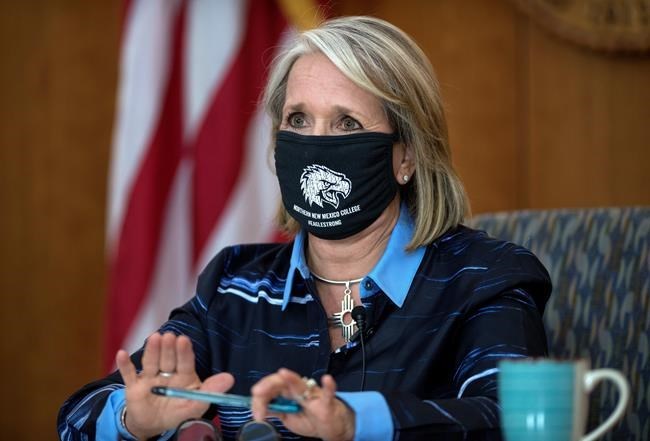
New Mexico Gov. Michelle Lujan Grisham gives her weekly update on COVID-19 and the state's effort to contain it during a virtual news conference from the state Capitol in Santa Fe, N.M., on Thursday, July 23, 2020. (Eddie Moore/The Albuquerque Journal via AP)
August 27, 2020 - 6:17 PM
SANTA FE, N.M. - Health officials are relaxing a pandemic stay-at-home order in New Mexico to allow larger public gatherings of up to 10 people and provide limited access to museums with static displays, Gov. Michelle Lujan Grisham announced Thursday.
Lujan Grisham and Human Services Secretary David Scrase likened the gradual reopening to slowly twisting a dimmer switch on a light fixture. The new public health order goes into effect Saturday with previously announced changes that restore indoor restaurant dining service for the first time in six weeks and allow greater attendance at indoor religious services.
“We just want to open up a little bit. We want to be very careful,” Scrase said. “We tried this before. It didn't work so well."
At the same time, the state's top education official announced that a post-labour Day return to part-time classroom learning for elementary school students will be limited to counties with low average rates of COVID-19 infection and positivity rates on virus testing.
“As we’re looking at bringing students back after Labor Day, we are only bringing students back that are in these green zones,” Public Education Secretary Ryan Stewart said.
To reopen classrooms, counties must have fewer than eight new daily cases on average per 100,000 residents, and positivity rate under 5%. The statewide average positivity rate is 2.1% — the lowest in the western U.S.
If applied today, the threshold would put public school classrooms off limits in eight counties clustered in the southeast region of the state and the far southwestern boot-heel region. The southeast area has been a cradle of dissent concerning state public health orders on COVID-19.
About one-fourth of school districts, including one of the nation's largest in Albuquerque, already have postponed in-person classroom learning until at least January.
The Public Education Department is reviewing re-entry plans that can introduce some classroom learning Sept. 8 on a rotating basis for K-5 students.
The state provides a universal opt-out for families who are not yet comfortable with returning their children to classrooms. Stewart said schools that seek to reopen classrooms must provide effective plans to rapidly respond to virus infections by quickly closing areas, tracing exposure, cleaning and eventually reopening again.
Lujan Grisham said her administration will defer to school districts on whether to resume classroom learning until there is an effective vaccine.
Public school classrooms currently are closed across the state as students follow lessons from home using remote technology that runs the gamut from live video-conference meetings to telephone calls.
In other pandemic-related news:
— Unemployment insurance benefits are getting a $300 weekly boost from the federal government.
The state Workforce Solutions Department announced Wednesday that its grant application for lost wage assistance was approved by the Federal Emergency Management Agency.
The $300 weekly increase applies retroactively to a three-week period beginning in late July. That's when a larger, $600 weekly federal supplement ran out. Standard unemployment benefits in New Mexico provide up to $461 weekly to individuals.
— New Mexico's seven-day rolling average of the positivity rate for COVID-19 has decreased over the past two weeks, going from 2.6% on Aug. 12 to 2.1% on Wednesday, according to an analysis by The Associated Press of data collected by Johns Hopkins University Center for Systems Science and Engineering.
Comparing seven-day averages of new cases smooths out anomalies in the data, including delays in daily test results.
State health officials Thursday announced 190 new virus cases and nine related deaths. That raises the pandemic tally to 24,920 cases and 764 deaths statewide.
The number of infections is thought to be far higher because many people have not been tested, and studies suggest people can be infected with the virus without feeling sick.
News from © The Associated Press, 2020